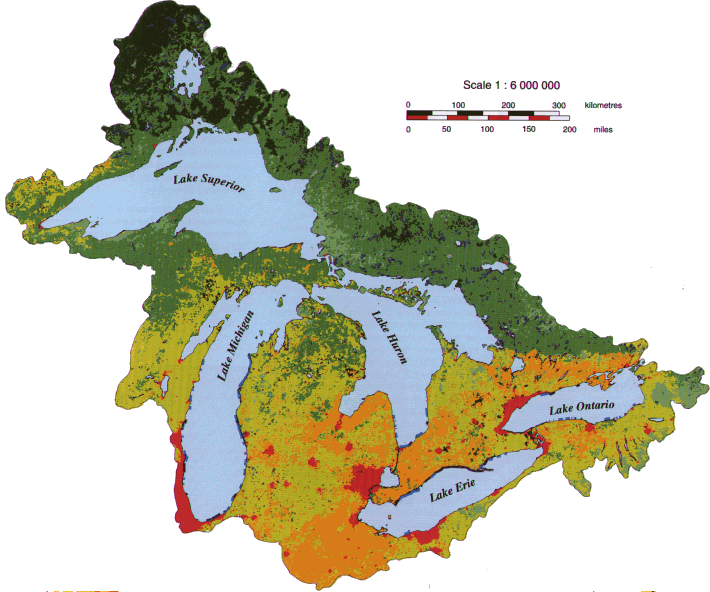Flow Alteration in Great Lakes Basin
Rivers: Extent and Effects
J. David Allan, Edward Rutherford,
Paul Seelbach, Michael J. Wiley,
Paul Webb, University of Michigan;
N. LeRoy Poff Colorado State University
Sponsor: Great Lakes Protection Fund
Alteration of the flow regimes of rivers
greatly impacts their ecological integrity. Through direct physical
change, including dams, culverts, dredging and channelization, the flow
of rivers has been dramatically altered. No less importantly, changing
land use, particularly the transformation of forested to agricultural and
urban lands, with increases in impermeability and runoff, has indirectly
altered river flow by affecting the hydrologic pathways that generate runoff.
This project addresses the need for a synoptic and basin-wide assessment
of the extent of flow regulation of Great Lakes tributaries, impacts on
the physical habitat and the biota, and the opportunities for innovative
and effective restoration. Through a coordinated program that includes
new research, analysis and synthesis of existing data, outreach, and web-based
information transfer, this project will provide a basin-wide assessment
of the ecological benefits of flow restoration. This science-based
synthesis of restoration potential will inform agency personnel, environmental
organizations and private grant makers of need, opportunity, and potential
targets for flow restoration, hopefully energizing the Great Lakes community
to restore the basin's ecological integrity.
 The
Natural Flow Regime paradigm provides a guiding concept and analytic foundation
for environmental restoration planning, implementation, and evaluation.
The central proposition of the Natural Flow Regime Paradigm (Poff et al.
1997) is that the ecological integrity of flowing water systems depends
on their natural dynamic character. Deviations from a natural flow
regime should then act as indicators of stream degradation. Altered
streamflows are well known to be associated with poor channel habitats,
accelerated erosion, bank instability, and diminished base flow.
Restoration of stream habitats and water quality therefore depends on restoring,
to the extent possible, the natural pattern of streamflow.
The
Natural Flow Regime paradigm provides a guiding concept and analytic foundation
for environmental restoration planning, implementation, and evaluation.
The central proposition of the Natural Flow Regime Paradigm (Poff et al.
1997) is that the ecological integrity of flowing water systems depends
on their natural dynamic character. Deviations from a natural flow
regime should then act as indicators of stream degradation. Altered
streamflows are well known to be associated with poor channel habitats,
accelerated erosion, bank instability, and diminished base flow.
Restoration of stream habitats and water quality therefore depends on restoring,
to the extent possible, the natural pattern of streamflow.
Project Goal:
Complete an analysis of flow regimes and their
degree of alteration for Great Lakes Basin rivers, accessible over the
web using maps and icons, and suitable for use by managers and community
groups in targeting restoration activities.
Specific Objectives:
1. Describe hydrologic regimes of (US) Great
Lakes Basin rivers
Spatial and temporal variability in hydrologic
regimes will be quantified for representative USGS streamflow gaging sites.
Using flow exceedence curves and indicators of hydrologic variability,
comparisons over the temporal record and among locations will reveal patterns
in flow regime and extent of flow alteration from river segments across
the US portion of the Great Lakes Basin.
2. Assess influence of dams and land
use on variation in flow regimes
The influence of dams vs land use on flow regimes
will be analyzed across space and through time by developing multiple regression
models of flow parameters, testing the explanatory power of independent
variables including land use, dams, climate, and physiography.
3. Determine how flow alteration affects
the fish assemblage
Using existing fish assemblage data for sites
that we can categorize hydrologically, we will determine changes in the
composition and relative abundance of species and in functional attributes,
in order to determine the extent to which fish assemblages have changed
in response to flow regime.
4. Map flow regime, flow alteration,
and relevant databases for restoration activities
Clickable maps will be provided over the internet,
displaying Great Lakes Basin rivers and their flow regimes, dams, fish
assemblages, and narrative information, making the outcomes of our investigations
readily accessible to potential users. Meetings with managers and
community groups early and near completion of this project will maximize
relevance of the disseminated outcomes.
 |

|
 |
|
Longnose Sucker
|
Gibson Dam
|
White Sucker
|
 The
Natural Flow Regime paradigm provides a guiding concept and analytic foundation
for environmental restoration planning, implementation, and evaluation.
The central proposition of the Natural Flow Regime Paradigm (Poff et al.
1997) is that the ecological integrity of flowing water systems depends
on their natural dynamic character. Deviations from a natural flow
regime should then act as indicators of stream degradation. Altered
streamflows are well known to be associated with poor channel habitats,
accelerated erosion, bank instability, and diminished base flow.
Restoration of stream habitats and water quality therefore depends on restoring,
to the extent possible, the natural pattern of streamflow.
The
Natural Flow Regime paradigm provides a guiding concept and analytic foundation
for environmental restoration planning, implementation, and evaluation.
The central proposition of the Natural Flow Regime Paradigm (Poff et al.
1997) is that the ecological integrity of flowing water systems depends
on their natural dynamic character. Deviations from a natural flow
regime should then act as indicators of stream degradation. Altered
streamflows are well known to be associated with poor channel habitats,
accelerated erosion, bank instability, and diminished base flow.
Restoration of stream habitats and water quality therefore depends on restoring,
to the extent possible, the natural pattern of streamflow.

